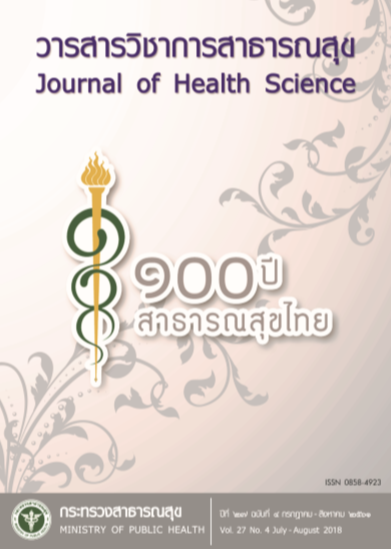An Integration of Prevention and Resolution to Teenage Pregnancy in 17 Provinces: Phase II Findings
Keywords:
teenage pregnancy, integration, mixed methods studyAbstract
This mixed methods study aimed to identify perceptions of a result from an integrations, level of required knowledge related to pregnancy prevention and safe sexual behaviors among teenage in schools, and outcomes of the integration. Research design was concurrent nested qual+quan. The study was con-ducted in 17 provinces during July 2016 - June 2018. In qualitative part, a purposive sampling and snowball technique were used to recruit key informants. Data was saturated at 1,401 participants. Focus group discussions, interviews and document analysis were employed for data collections. Data was ana-lyzed by thematic analysis. In the survey part, two-stage cluster sampling was used and there were 10,025 students of high school grades two and four, and second year vocational students participated in the study. A set of questionnaire was used for data collection and descriptive statistics was employed for analysis. Analyzed data from both qualitative study and survey of all provinces were pulled to combine for identi-fying research results. The findings were as follow. Firstly, nine missions leading to integration and eight sets of knowledge were emerged. Secondly, percentage of students with required knowledge reach 70 percent and above was 45.0-80.0. Percentages of vocational students, high school grade four and high school grade two students who had sexual experienced were 41.4, 12.8 and 6.3. An average age at the first sexual engagement was 14-15 years old. Ninety percent of students who had sexual experienced used contraceptive devicesat the first engagement and 92.0% at their last sexual encounter. Condom used in the last encounter was slightly lower than the first one. Thirdly, the rate of delivery in women aged under 20 decreased while number of repeated pregnancy increased; and there was increasing number of providing contraceptive implant for teens. Data on female and male students leaving school due to pregnancy were not available in all provinces. The findings revealed that the integration employed in 17 provinces created a number of knowledge resulting in favorite findings. It is suggested that dissemination of the knowledge would contribute to the work of the provincial committees on teenage pregnancy inorder to move forward strategies indicated in the Teenage Pregnancy Act 2017.
Downloads
Downloads
Published
How to Cite
Issue
Section
License
Copyright (c) 2018 Journal of Health Science- วารสารวิชาการสาธารณสุข

This work is licensed under a Creative Commons Attribution-NonCommercial-NoDerivatives 4.0 International License.







